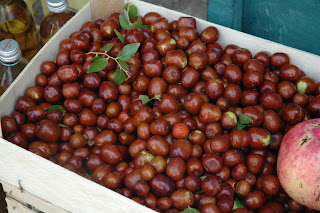 |
| The 100-foot Romanca, a wooden sailing ship, was our home during our Adriatic voyage among Croatia's pristine islands. |
 |
| We head for Hvar , sunniest place in Croatia, aboard the ship's dinghy |
 |
| This map shows our three port calls on the lovely Croatian island of Hvar. |
Hvar Island, the sunniest place in all of Croatia, is a study in contrasts.
Most “discovered” among the Adriatic islands offshore between Split and Dubrovnik, it’s easily reached on routes plied by the Jadrolina ferry.
The scents of lavender and fresh baking reached us even before our ship’s dinghy carrying us ashore had reached the landing. To my mind, the salt air acts in much the same way as winter does at home: a deprivation of scents makes those encountered more profound.
Those of us from the Romanca felt little kinship with the elegant beautiful people who make Hvar’s shops, bars and waterfront strolls a see-and-be-seen destination. It reminded me of Monaco and other glamor-drenched towns along the French Riviera.
We’d been together aboard the 100-foot wooden sailing ship for a week and had bonded into our own small community of explorers. We ogled the Seven Sins motor yacht moored nearby and, once back aboard, one of us Googled the Seven Sins to learn that it, too, was a charter, going for 129,500 euros (about $200,000!) a week.
But we had UNESCO World Heritage Site lace on our minds. Watching the clock, we headed uphill to visit the lace-making nuns at a Benedictine convent established here on Hvar in 1664. We needed to get there before noon because the nuns shut their doors to the public then.
In the early 1800s as the sisters taught domestic skills to young women of the town, they developed a unique handcraft framed around the raw materials available to them. They figured out how to make lace from the dried strands of agave leaves — a widespread succulent plant growing wild throughout the island. Agave is, in fact, the same plant from which tequila is made in Mexico, and I’d seen its tall flower, which blooms every hundred years, used as a Christmas tree on several Caribbean islands.
The nuns harvest the fat green, thorn-edged leaves of the tropical lilies and carefully draw the fiber from them to make thread. The technique, along with their lace-making skills have been passed down through generations of sisters. The patterns are of their own creation.
 |
| This lace, created by nuns in a Hvar convent, is crafted from fibers drawn from the fat leaves of agave, the same plant from which tequila is made in Mexico. |
The lace and the tools used to make it are seen carefully preserved under glass in a small one-room museum. It is also sold by the nuns.
Our shipmate whipped out her credit card as she approached the small counter where handmade lace items were displayed. A small sign noted the lace is not to be washed, dry cleaned or ironed. It’s obviously lace meant to be framed, not used on chair arms as my grandmother did with hers.
A brief conversation ensued as the clock began to strike the noon hour. Reluctantly, it seemed, our shipmate put her credit card away and we prepared to leave, shepherded through the large arched stone door by the stern-faced sister.
“The prices for the lace start at about $700 and go up from there,” our colleague explained. “I love the lace but not that much.”
 |
| Jet setters and other beautiful people stroll the Hvar waterfront. |
The day was heating up, so a few of us stopped for a cool drink along the waterfront promenade, where we watched the beautiful people. The shoppers among us meandered among shops and stalls and everyone bought lavender, which grows all over Hvar and several other Adriatic islands.
We wandered up to the other side of town, where a guided tour had been arranged for us at a 15th-century Franciscan monastery.
A striking Last Supper painting filled a full wall of the monks’ refectory.
“The artist, who was sick, was thrown ashore from a passing ship when its sailors feared he would infect them,” our guide said. “The monks took him in and nursed him back to health early in the 17th century. He was so grateful he did this painting for them.”
The courtyard outside is presided over by a nearly 500-year-old cypress tree also believed planted by the same artist.

 RSS
RSS




































